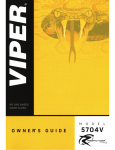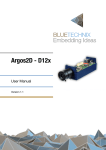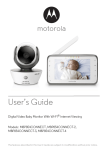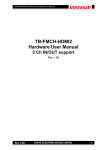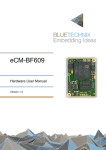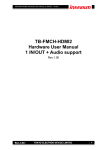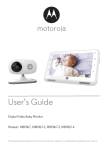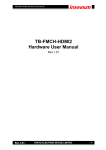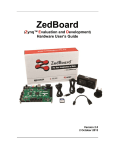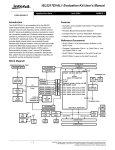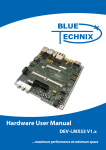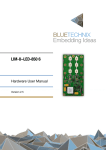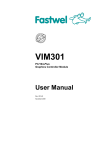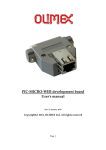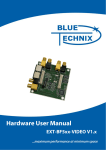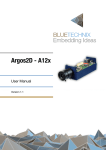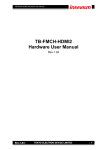Download User Manual - eDEV-BF6xx
Transcript
eDEV-BF6xx Hardware User Manual Version 1.2 Contact Bluetechnix GmbH Waidhausenstraße 3/19 A-1140 Vienna AUSTRIA [email protected] http://www.bluetechnix.com Date: 2014-01-13 Template No.: 900-306 / A Page 2 | 32 Table of Contents 1 Introduction ...................................................................................................................................... 7 1.1 Overview ................................................................................................................................... 7 1.2 Key Features ............................................................................................................................. 7 1.2.1 eCM-BF609........................................................................................................................ 7 1.2.2 Active components on eDEV-BF6xx ................................................................................. 8 1.3 2 General Description .......................................................................................................................... 9 2.1 Core Module .................................................................................................................... 10 2.1.2 Power Architecture .......................................................................................................... 10 2.1.3 JTAG ................................................................................................................................ 11 2.1.4 Link Port ........................................................................................................................... 12 2.1.5 RS-232 / RS-485 ............................................................................................................. 12 2.1.6 CAN Bus .......................................................................................................................... 12 2.1.7 GPIOs ............................................................................................................................... 13 2.1.8 Debug UART .................................................................................................................... 13 2.1.9 Audio codec ..................................................................................................................... 13 2.1.10 Temperature sensor ......................................................................................................... 13 2.1.11 User LEDs and push-button ............................................................................................ 14 2.1.12 Reset button .................................................................................................................... 14 2.1.13 Ethernet ............................................................................................................................ 14 2.1.14 USB-OTG ......................................................................................................................... 14 2.1.15 SD-Card ........................................................................................................................... 14 2.1.16 Real Time Controller ........................................................................................................ 15 2.1.17 ISM Camera Interfaces .................................................................................................... 15 2.1.18 LVDS0 with Touch Controller .......................................................................................... 15 2.1.19 LVDS1 .............................................................................................................................. 16 2.1.20 HDMI ................................................................................................................................ 16 2.1.21 Extension connectors ...................................................................................................... 17 Boot Mode .............................................................................................................................. 17 Specifications ................................................................................................................................. 19 3.1 4 Functional Description ............................................................................................................ 10 2.1.1 2.2 3 Applications............................................................................................................................... 8 Electrical Specifications .......................................................................................................... 19 3.1.1 Operating Conditions ....................................................................................................... 19 3.1.2 Maximum Ratings ............................................................................................................ 19 3.1.3 ESD Sensitivity ................................................................................................................. 19 Connector Description ................................................................................................................... 20 Template No.: 900-306 / A Page 3 | 32 4.1 X5 - Power supply ................................................................................................................... 20 4.2 X3 and X16 – Link Port and JTAG .......................................................................................... 20 4.3 X12 – JTAG ............................................................................................................................. 20 4.4 X11 – RS-232/485, CAN Bus and GPIOs ............................................................................... 21 4.5 X13 – Debug UART ................................................................................................................. 21 4.6 X14 – UART1 ........................................................................................................................... 21 4.7 X4 – Audio ............................................................................................................................... 21 4.8 X7 – Ethernet ........................................................................................................................... 22 4.9 X8 – USB-OTG ........................................................................................................................ 22 4.10 X9 – SD-Card slot ................................................................................................................ 22 4.11 G1 – Backup battery holder ................................................................................................ 22 4.12 X6 and X22 – ISM Camera .................................................................................................. 23 4.13 X21 and X23 – LVDS Display .............................................................................................. 23 4.14 X19 and X24 – Display Backlight ........................................................................................ 23 4.15 X20 – Touch screen ............................................................................................................. 24 4.16 X18 – HDMI.......................................................................................................................... 24 4.17 X1 and X2 – Extension......................................................................................................... 24 5 Mechanical Outline ......................................................................................................................... 25 5.1 Top View ................................................................................................................................. 25 5.2 Bottom View ............................................................................................................................ 25 6 Support ........................................................................................................................................... 26 6.1 General Support ...................................................................................................................... 26 6.2 Board Support Packages ........................................................................................................ 26 6.3 Blackfin® Software Support ................................................................................................... 26 6.3.1 BLACKSheep® OS .......................................................................................................... 26 6.3.2 LabVIEW .......................................................................................................................... 26 6.3.3 uClinux ............................................................................................................................. 26 6.4 Blackfin® Design Services ....................................................................................................... 26 6.4.1 7 Upcoming Products and Software Releases .................................................................. 26 Ordering Information ...................................................................................................................... 27 7.1 8 eDEV-BF6xx and Accessories ................................................................................................ 27 Dependability ................................................................................................................................. 28 8.1 9 MTBF ....................................................................................................................................... 28 Product History .............................................................................................................................. 29 9.1 Version Information ................................................................................................................. 29 9.1.1 9.2 10 eDEV-BF6xx ..................................................................................................................... 29 Anomalies ................................................................................................................................ 29 Document Revision History ........................................................................................................ 30 Template No.: 900-306 / A Page 4 | 32 11 A List of Abbreviations ................................................................................................................... 31 List of Figures and Tables .............................................................................................................. 32 Template No.: 900-306 / A Page 5 | 32 © Bluetechnix GmbH 2014 All Rights Reserved. The information herein is given to describe certain components and shall not be considered as a guarantee of characteristics. Terms of delivery and rights of technical change reserved. We hereby disclaim any warranties, including but not limited to warranties of non-infringement, regarding circuits, descriptions and charts stated herein. Bluetechnix makes and you receive no warranties or conditions, express, implied, statutory or in any communication with you. Bluetechnix specifically disclaims any implied warranty of merchantability or fitness for a particular purpose. Bluetechnix takes no liability for any damages and errors causing of the usage of this board. The user of this board is responsible by himself for the functionality of his application. He is allowed to use the board only if he has the qualification. More information is found in the General Terms and Conditions (AGB). Information For further information on technology, delivery terms and conditions and prices please contact Bluetechnix http://www.bluetechnix.com. Warning Due to technical requirements components may contain dangerous substances. Template No.: 900-306 / A Page 6 | 32 Hardware User Manual - eDEV-BF6xx 1 Last change: 13 January 2014 Version 1.2 Introduction The eDEV-BF6xx Development Board is a feature rich, low cost rapid development platform designed to decrease time-to-market of customized applications. It is designed to support Bluetechnix latest powerful Blackfin® based Core Module the eCM-BF609. The development board provides all interfaces on dedicated connectors and has all Core Module pins routed to solder pads which can be easily accessed by the developers. This allows customers to connect their own hardware and enables comfortable measurements. The eDEV-BF6xx supports JTAG, ADIs USB Emulator-100B and features an extender socket (bottom side) for upcoming extender boards. 1.1 Overview Ethernet USB-OTG Mini-A/B HDMI-A USB Terminal Mini-B SDHC Card Slot 24-Bit LVDS + Touch Touch Controller HDMI Transmitter UART-USB Bridge Extension Connectors 18-Bit LVDS JTAG Bluetechnix eCM-BF609 2 x 14-Bit ISM SUB-D RS-232/485 / CAN Transmitter 3 x Audio Jack Audio Codec Status LEDs Reset / User Button Core Module 2 x Link Port RTC Battery Holder Temperature sensor Power Supply DC Plug DIP Switches Boot mode Solder Pads Active Components User Interfaces Connectors Figure 1-1 Overview of the main components 1.2 Key Features 1.2.1 eCM-BF609 The eCM-BF609 offers following features: • Analog Devices Blackfin Dual-Core Processor ADSP-BF609 Template No.: 900-306 / A Page 7 | 32 Hardware User Manual - eDEV-BF6xx • 256MB DDR2 SDRAM • 8MB SPI-Flash • Ethernet-PHY KSZ8031RNLI • Single power supply (3.3V) • All peripherals available on connectors • Industrial and commercial temperature range Last change: 13 January 2014 Version 1.2 For further information see the eCM-BF609 Hardware User Manual available at http://www.bluetechnix.com/. 1.2.2 Active components on eDEV-BF6xx • 5V Voltage regulator (Analog Devices ADP2301) • 3.3V Voltage regulator (Analog Devices ADP2302) • 2.87V and 1.8V Voltage regulator (Analog Devices ADP123) • HDMI Transmitter (Analog Devices ADV7511) • Audio codec (Analog Devices ADAU1761) • 24-Bit LVDS Transceiver (Texas Instruments DS90C385A) • 18-Bit LVDS Transceiver (Texas Instruments DS90CR217) • Touch-screen controller (Analog Devices AD7843) • Real time clock with coin cell holder (NXP PCF2129A) • RS-232 Transceiver (Intersil ICL3222) • RS-485 Transceiver (Intersil ISL3179E) • CAN Transceiver (Texas Instruments SN65HVD232D) • USB-UART Bridge (Silicon Labs CP2102) • Temperature sensor (Analog Devices ADT7408) Please understand that these are only active parts and require additional connectors and passive parts as well. We provide information regarding these parts on request. 1.3 Applications Machine Vision - Object counting/detection Robotics – Autonomous Path finding/Map building Surveillance Systems – People tracking Parallel digital signal processing Automotive - Vision Systems/Surround view Template No.: 900-306 / A Page 8 | 32 Hardware User Manual - eDEV-BF6xx 2 Last change: 13 January 2014 Version 1.2 General Description The following chapters describes the functions of the board interfaces listed below. Figure 2-1 Position of user interfaces on top layer Template No.: 900-306 / A Page 9 | 32 Hardware User Manual - eDEV-BF6xx Last change: 13 January 2014 Version 1.2 Figure 2-2 Position of user interfaces on bottom layer 2.1 Functional Description 2.1.1 Core Module The eDEV-BF6xx provides two connectors in the middle of the board to connect a Bluetechnix eCM-BF6xx Core Module to the development board. For further information see Hardware User Manual of eCM-BF609 available at http://www.bluetechnix.com/ . 2.1.2 Power Architecture The eDEV-BF6xx must be powered by an external 12V power supply connected to X5. The minimum requirements for external power supply is 12V @ 1.5A. The eDEV-BF6xx has four voltage domains: 3.3V, 5V, 2.87V, 1.8V. Following voltage regulators are used to provide the necessary power domains to the board: • U3 (Analog Devices ADP2302) provides 3.3V @ 2A. • U4 (Analog Devices ADP2301) provides 5.0V @ 1A. • U5 and U6 (Analog Devices ADP123) provides 2.87V @ 300mA. • U7 (Analog Devices ADP123) provides 1.8V @ 300mA. Template No.: 900-306 / A Page 10 | 32 Hardware User Manual - eDEV-BF6xx 2.1.3 Last change: 13 January 2014 Version 1.2 JTAG The eDEV-BF6xx design enables a multi-processor JTAG session using connectors X3 and X16. By default, the board is set up in single-processor mode. For a dual eDEV-BF6xx session, connect two eDEV-BF6xx via connectors X3 and X16. Flip one of the two eDEV-BF6xx by 180 degrees to allow the boards to mate (see Figure 2-3). For a multi-processor JTAG session only one external emulator connected to X12 is required. Note that each eDEV-BF6xx requires its own power supply. Board A Board B X12 X3 S1 X16 X16 S1 X3 Figure 2-3 Multi-processor JTAG session For three or more eDEV-BF6xx sessions, connect each of the boards with JTAG cables. The cables connect JTAG pins of each board and put the eDEV-BF6xx in a JTAG serial chain. For three eDEV-BF6xx, three JTAG cables are required. Similarly, for four eDEV-BF6xx, four JTAG cables are required. Part numbers for Samtec standard, off the shelf link port cables can be found in Table 4.2. Note that each respective eDEV-BF6xx board also requires its own power supply. To switch between single- and multi-processor modes, use the DIP switch S1 (see Table 2.1). Session Single-processor S1 settings 1 2 3 4 5 6 7 8 Multi-processor (Emulator connected – Board A) 1 2 3 4 5 6 7 8 Multi-processor (no Emulator connected – Board B) 1 2 3 4 5 6 7 8 On Off On Off On Off Table 2.1: DIP switch S1 settings Template No.: 900-306 / A Page 11 | 32 Hardware User Manual - eDEV-BF6xx 2.1.4 Last change: 13 January 2014 Version 1.2 Link Port The ADSP-BF60x processors has 4 dedicated link ports. Each link port has a clock pin, an acknowledgment pin, and eight data pins. The ports can operate at up to 83 MHz and act as either a receiver or a transmitter. The ports are used to connect to other ADSP-BF60x processors which also have the link ports pins routed to dedicated connectors. The eDEV-BF6xx enables access to link ports 0 and 1 via connectors X3 and X16, respectively. Two eDEVBF6xx can be connected via the link port connectors (see Figure 2-3). The processors communicate via the link ports, all while performing independent tasks on each of the eDEV-BF6xx. To loopback the link port connectors on one eDEV-BF6xx or connect three or more eDEV-BF6xx, obtain a standard, off the shelf connector from Samtec. For more information, see Table 4.2: Connector description X3 and X16. Link port 0 can be selected as the boot source by setting the boot mode according to Table 2.12. 2.1.5 RS-232 / RS-485 The eDEV-BF6xx provides a full-duplex RS-232 and a half-duplex RS-485 interface on the SUB-D connector X11. Both transceivers are sharing the UART0 interface of the Core Module. The active transceiver can be selected with DIP switch S2 (see Table 2.2). Function RS-232 Transceiver enabled S2 settings 1 2 3 4 5 6 7 8 RS-485 Transceiver enabled 1 2 3 4 5 6 7 8 On Off On Off Table 2.2: DIP switch S2 settings for RS-232/485 interfaces If the RS-485 transceiver is activated, PD9 is used to switch between receive and transmit mode (see Table 2.3). PD9 Level Low High RS-485 Transceiver Mode Receiver output enable Driver output enable Table 2.3: PD9 function For further information see Table 4.3. 2.1.6 CAN Bus The eDEV-BF6xx provides a CAN Bus interface on the SUB-D connector X11. A 120Ω termination resistor can be activated with the DIP switch S2. Function 120Ω Termination resistor OFF S2 settings 1 2 3 4 5 6 7 8 Template No.: 900-306 / A On Off Page 12 | 32 Hardware User Manual - eDEV-BF6xx Last change: 13 January 2014 Version 1.2 Function 120Ω Termination resistor ON S2 settings 1 2 3 4 5 6 7 8 On Off Table 2.4: DIP switch S2 settings for CAN Bus termination resistor For further information see Table 4.3 and Table 2.12. 2.1.7 GPIOs The eDEV-BF6xx provides easy access to all GPIOs of the eCM-BF6xx Core Module. All GPIOs are routed to test pads with 2.54mm pitch. The GPIOs PD10 and PG8 are also routed to the SUB-D connector X11. For further information see Table 4.3. 2.1.8 Debug UART The eDEV-BF6x provides a USB to UART Bridge (Silicon Labs CP2102) between the UART1 interface of the eCM-BF6xx and the USB connector X13. The UART1 signals are also accessible through the connector X14. For further information see Table 4.4 and Table 4.5. 2.1.9 Audio codec The eDEV-BF6xx provides an audio interface to the eCM-BF6xx through the 3-way connector X4 and the audio codec ADAU1761 from Analog Devices. The audio codec is connected to the SPORT2 and TWI0 interfaces of the eCM-BF6xx. The I²C slave address of the audio codec is set to 0x38. The connector X4 provides an interface to the headphone (red jack), line-out (green jack) and line-in (blue jack) interface of the audio codec. Further interfaces are routed to test pads for debugging purposes. Function Audio codec enabled S4 settings 1 2 3 4 CAN enabled 1 2 3 4 On Off On Off Table 2.5: DIP switch S4 settings For further information see Table 4.6. 2.1.10 Temperature sensor The eDEV-BF6xx provides a temperature sensor (U16) connected to the TWI0 interface. The I²C slave address is set to 0x18. Template No.: 900-306 / A Page 13 | 32 Hardware User Manual - eDEV-BF6xx Last change: 13 January 2014 Version 1.2 2.1.11 User LEDs and push-button The eDEV-BF6xx provides a red LED (V8) connected to PC15 and a green LED (V9) connected to PC14. This LEDs can be disconnected from GPIOs using the DIP switch S2 (see TBD). The eDEV-BF6xx provides also a push-button (S3) connected to PC13. This push-button can be disconnected from PC13 using S2. Part S2 settings Connected to GPIO Red LED V8 1 2 3 4 5 6 7 8 Green LED V9 1 2 3 4 5 6 7 8 Push-button S3 1 2 3 4 5 6 7 8 S2 settings Disconnected from GPIO On Off On Off On Off 1 2 3 4 5 6 7 8 1 2 3 4 5 6 7 8 1 2 3 4 5 6 7 8 On Off On Off On Off Table 2.6: DIP switch S2 settings for LEDs and push-button 2.1.12 Reset button The eDEV-BF6xx provides a reset button S5 to reset the board. 2.1.13 Ethernet The eDEV-BF6xx provides a 10/100-Mbit Ethernet interface on the RJ45 connector X7. For further information see Table 4.7. NOTE: The eCM-BF609 provides only one LED signal connected to the yellow LED of X7 to show Ethernet activity. 2.1.14 USB-OTG The eDEV-BF6xx provides a USB-OTG interface to the eCM-BF6xx through the USB Mini A/B connector X8. The board allows 5V at 500mA to a peripheral by enabling the FET switch U8. The USB controller of the ADSP-BF6xx has native support for controlling the FET trough the USB_VBC signal. For further information see Table 4.8. 2.1.15 SD-Card The eDEV-BF6xx provides a SD-Card slot X9 connected to the RSI interface of the eCM-BF6xx. The CD (card detect) pin is connected to PE13 and the WP (write protect) pin is connected to PE12. For further information see Table 4.9. Template No.: 900-306 / A Page 14 | 32 Hardware User Manual - eDEV-BF6xx Last change: 13 January 2014 Version 1.2 2.1.16 Real Time Controller The eDEV-BF6xx provides a real time controller (NXP PCF2129) connected to the TWI0 interface. The I²C slave address of the real time controller is set to 0x51. A 3.0V backup battery can be inserted in the battery holder G1 to provide power to the RTC when the board isn’t supplied by the external power supply. For further information see Table 4.10. 2.1.17 ISM Camera Interfaces The eDEV-BF6xx provides two ISM camera interface to connect a Bluetechnix ISM camera module to the board. Both interfaces support ISM modules up to 14-Bit of parallel data using the EPPI1 for ISM0 (X6) and EPPI2 for ISM1 (X22). Both cameras can be configured through the TWI0 interface. Each ISM interface has its own I²C slave address and can be changed by the resistors R28 and R90 (see Table 2.7). Interface ISM0 Resistor mount R28 mounted Function SADDR0 = 0 ISM1 R28 not mounted (default) R90 mounted (default) SADDR0 = 1 SADDR0 = 0 R90 not mounted SADDR0 = 1 Table 2.7 ISM I²C slave addresses For further information see Table 4.11. 2.1.18 LVDS0 with Touch Controller The eDEV-BF6xx provides a 24-Bit LVDS interface connected to EPPI0 on connector X21. The LVDS signals are generated by a LVDS transmitter (Texas Instruments DS90C385A) and routed to connector X21. This interface can be used in conjunction with the connectors X19 (Backlight) and X20 (Resistive touch display) to control a TFT touch display. The touch controller (Analog Devices AD7843) is connected to the SPI0 interface and SPI0_SEL3 (PD0) is used to control the nCS signal of the touch controller. The interrupt pin of the touch controller is connected to PB6 of the eCM-BF6xx Core Module. The image on the display can be flipped by 180° using the DPS signal of the TFT display. S2 settings 1 2 3 4 5 6 7 8 1 2 3 4 5 6 7 8 On Off On Off Function Reverse Scan Function Disabled Reverse Scan Function Enabled Table 2.8: DIP switch S2 settings for DPS function of LVDS0 For further information see Table 4.11, Table 4.12 and Table 4.13. Template No.: 900-306 / A Page 15 | 32 Hardware User Manual - eDEV-BF6xx Last change: 13 January 2014 Version 1.2 2.1.19 LVDS1 The eDEV-BF6xx provides an 18-Bit LVDS interface connected to EPPI2 on connector X23. The LVDS signals are generated by a LVDS transmitter (Texas Instruments DS90CR217) and routed to connector X23. This interface can be used in conjunction with the connectors X24 (Backlight) to control a TFT display. The image on the display can be flipped by 180° using the DPS signal of the TFT display. S2 settings 1 2 3 4 5 6 7 8 1 2 3 4 5 6 7 8 On Off On Off Function Reverse Scan Function Disabled Reverse Scan Function Enabled Table 2.9: DIP switch S2 settings for DPS function of LVDS1 For further information see Table 4.11 and Table 4.12 2.1.20 HDMI The eDEV-BF6xx provides the high performance HDMI Transmitter ADV7511 from Analog Devices connected to the HDMI Type A connector X18. The ADV7511 is a 225 MHz high-definition multimedia interface (HDMI) transmitter, which is ideal for home entertainment products including DVD players/receivers, digital set top boxes, A/V receivers, gaming consoles and PCs. The digital video interface contains an HDMI v1.4 and a DVI v1.0 compatible transmitter and supports all HDTV formats (including 1080p with 12-bit Deep Color). The ADV7511 supports the HDMI v1.4 specific features, HEAC (ARC), and 3D video. In addition, the ADV7511 supports x.v.Color, high bit rate audio and programmable AVI Info Frames features. With the inclusion of HDCP, the ADV7511 allows the secure transmission of protected content as specified by the HDCP v1.4 protocol. The ADV7511 high-performance HDMI transmitter with ARC connects to the 16-Bit EPPI0, SPORT0 and of the eCM-BF6xx. The ADV7511 can be configured to generate an interrupt based on various events. The TWI0 interface is used for communication between the transmitter and processor. The EPPI0 is used for transmitting video data in YUV (UYVY) format. The SPORT0 is used for transmitting audio data. The I²C slave address of the ADV7511 is set to 0x39. The clock signal for the EPPI0 can be provide from an external 74.25MHz oscillator or can be generated by the EPPI0 of the eCM-BF6xx. Use the DIP switch S2 to select the clock source. Function External 74.25MHz Clock connected to EPPI0 S2 settings 1 2 3 4 5 6 7 8 Template No.: 900-306 / A On Off Page 16 | 32 Hardware User Manual - eDEV-BF6xx Last change: 13 January 2014 Version 1.2 Function External 74.25MHz Clock disconnected from EPPI0 S2 settings 1 2 3 4 5 6 7 8 On Off Table 2.10: DIP switch S2 settings for EN_74.25MHz For further information see Table 4.15. 2.1.21 Extension connectors The eDEV-BF6xx provides all signals of the eCM-BF6xx to the extension connectors X1 and X2. The extension connectors are located on the bottom side of the board. The connectors allow a Bluetechnix extension board or a custom-design daughter board to be connected to the eDEV-BF6xx. Limits to current and interface speed must be taken into consideration when using the extension connectors. Current for the extension board can be sources from the eDEV-BF6xx; therefore, the current should be limited to following limits: Supply VIN 3V3 Max. Current [mA] 700 300 Requirement No display connected to eDEV-BF6xx Table 2.11: Current limits for extension boards If more current is required, then a separate power connector and a regulator must be designed on the extension board. Additional circuitry can add extra loading to signals, decreasing their maximum effective speed. NOTE: Bluetechnix is not responsible for the effects of additional circuitry. For further information see Table 4.16. 2.2 Boot Mode The eDEV-BF6xx supports following boot modes: Boot mode No boot / Idle S6 settings 1 2 3 4 Memory 1 2 3 4 RSI0 Master 1 2 3 4 SPI0 Master (onboard SPI Flash) 1 2 3 4 SPI0 Slave 1 2 3 4 Template No.: 900-306 / A On Off On Off On Off On Off On Off Page 17 | 32 Hardware User Manual - eDEV-BF6xx Boot mode LP0 Slave Last change: 13 January 2014 Version 1.2 S6 settings 1 2 3 4 UART0 Slave 1 2 3 4 On Off On Off Table 2.12: DIP switch S6 settings Template No.: 900-306 / A Page 18 | 32 Hardware User Manual - eDEV-BF6xx 3 Last change: 13 January 2014 Version 1.2 Specifications 3.1 Electrical Specifications 3.1.1 Symbol VIN IIN VRTC IRTC Operating Conditions Parameter Input supply voltage Input current RTC supply voltage RTC current Min 1500 - Typical 12 3 50 Max 2000 100 Unit V mA V nA Table 3.1: Electrical characteristics 3.1.2 Maximum Ratings Stressing the device above the rating listed in the absolute maximum ratings table may cause permanent damage to the device. These are stress ratings only. Operation of the device at these or any other conditions greater than those indicated in the operating sections of this specification is not implied. Exposure to absolute maximum rating conditions for extended periods may affect device reliability. Symbol VIN VIO TAMB TSTO φAMB Parameter Input supply voltage Input or output voltage Ambient temperature Storage temperature Relative ambient humidity Min 0 -0.5 0 -20 Max 12.5 3.6 70 85 90 Unit V V °C °C % Table 3.2: Absolute maximum ratings 3.1.3 ESD Sensitivity ESD (electrostatic discharge) sensitive device. Charged devices and circuit boards can discharge without detection. Although this product features patented or proprietary protection circuitry, damage may occur on devices subjected to high energy ESD. Therefore, proper ESD precautions should be taken to avoid performance degradation or loss of functionality. Template No.: 900-306 / A Page 19 | 32 Hardware User Manual - eDEV-BF6xx 4 4.1 Last change: 13 January 2014 Version 1.2 Connector Description X5 - Power supply This is the main power supply connector for the board. Use a standard DC power plug with 5.5x2.5mm diameter to power the board. Minimum requirements for external power supply: 12V @ 1.5A. Figure 4-1 Polarity of the external power supply Descriptor X5 Description DC Power, RA Manufacturer Cui Part Number CUI-PJ-002AH-SMT DC Power Plug Mating Connector Cliff Electronic Components DCPP2 Table 4.1: Connector description X5 4.2 X3 and X16 – Link Port and JTAG The connectors X3 and X16 provide access to the Link Port and JTAG signals of the eCM-BF6xx Core Module. X3 supports link port 1 and the X16 connector is for link port 0. Descriptor X3 Description ERM8 10x2, RA male Manufacturer Samtec Part Number ERM8-010-01-L-D-RA-TR X16 ERF8 10X2, RA female Samtec ERF8-010-01-S-D-RA-L-TR 6" cable ERF8 to ERM8 10X2 Mating Connector Samtec ERCD-010-06.00-TBL-SBR-1 Table 4.2: Connector description X3 and X16 4.3 X12 – JTAG The JTAG interface of the Core Module is connected to the 14-pin 2.54mm header, X12. Pin 3 is missing to provide keying. Pin 3 in the mating connector must have a plug. For more information, see chapter 2.1.3.The JTAG connector is compliant with any Blackfin JTAG Emulator from Analog Devices. Template No.: 900-306 / A Page 20 | 32 Hardware User Manual - eDEV-BF6xx 4.4 Last change: 13 January 2014 Version 1.2 X11 – RS-232/485, CAN Bus and GPIOs The SUB-D connector X11 provides access to the RS-232, RS-485, CAN Bus and two GPIOs. Descriptor X11 Description SUB-D, RA female Manufacturer Multicomp Part Number 5504F1-09S-02A-03 Mating Connector Multicomp 5504F1-09P-02A-03 SUB-D, RA male Table 4.3: Connector description X11 4.5 X13 – Debug UART The USB Mini-B connector X13 provides access to the Debug UART (UART1) through the USB to UART Bridge. Descriptor X13 Description USB Mini-B, RA Manufacturer Molex Part Number 675031020 USB Mini-B OTG-STD A Mating Cable Molex 88732-8600 Table 4.4: Connector description X13 4.6 X14 – UART1 The header connector X14 (not mounted) provides access to the UART1 signals of the eCM-BF6xx Core Module. Descriptor X14 Description Header, 4-Pin Manufacturer Harwin Part Number M20-9990445 Mating Connector Harwin M20-1060400 Crimp housing, 4-Way Table 4.5: Connector description X14 4.7 X4 – Audio The 3-way connector X4 provides an audio interface to the eCM-BF6xx through the audio codec. Descriptor X4 Description 3-way stereo 3.5mm, RA 3.5mm stereo cable Manufacturer Anytronic Part Number SCJ374R5-3P Mating Connector Pro Signal AV02559 Table 4.6: Connector description X4 Template No.: 900-306 / A Page 21 | 32 Hardware User Manual - eDEV-BF6xx 4.8 Last change: 13 January 2014 Version 1.2 X7 – Ethernet The RJ45 connector X7 provides a 10/100Mbit Ethernet interface to the eCM-BF6xx. Descriptor X7 Description 10/100Mbit RJ45, RA Manufacturer Taimag Part Number RJSL-003TC1 CAT5 cable Mating Cable Molex Premise Network PCD-01000-0E Table 4.7: Connector description X7 4.9 X8 – USB-OTG The USB Mini A/B connector X8 provides the USB-OTG interface to the eCM-BF6xx. Descriptor X8 Description USB Mini A/B, RA Manufacturer Molex Part Number 56579-0576 USB cable, Mini-B OTG-STD A Mating Cable Molex 88732-8600 Table 4.8: Connector description X8 4.10 X9 – SD-Card slot The SD-Card slot X9 provides an interface to a SD-Card through the RSI interface. Descriptor X9 Description SD-Card slot Manufacturer Multicomp Part Number MC34459 SDHC Ultra II Mating Card Sandisk SD4814 Table 4.9: Connector description X9 4.11 G1 – Backup battery holder The backup battery holder provides a power supply to the RTC when no external power supply is applied to the board. Descriptor G1 Description Battery holder, 1216/1220/1225 3V Lithium battery Manufacturer Keystone Electronics Mating Battery Multicomp Part Number 3000TR CR1220 Table 4.10: Connector description G1 Template No.: 900-306 / A Page 22 | 32 Hardware User Manual - eDEV-BF6xx Last change: 13 January 2014 Version 1.2 4.12 X6 and X22 – ISM Camera The ISM connectors provides an interface to Bluetechnix ISM camera modules. Descriptor X6 and X22 Description FFC/FPC Connector, 0.5mm, 30 Pos., RA Manufacturer Samtec Mating Cable ZIF Cable, 0.5mm, 50mm, 30Pos Samtec Aptina MT9M025 Aptina MT9M131 Aptina MT9P031 See www.bluetechnix.com Mating Modules Bluetechnix GmbH Bluetechnix GmbH Bluetechnix GmbH Part Number ZF5-30-02-T-WT FJH-30-D-02.00-4 ISM-MT9M025 ISM-MT9M131-Color ISM-MT9P031 Table 4.11: Connector description X6 and X22 4.13 X21 and X23 – LVDS Display The LVDS display connectors provides interfaces to TFT (touch) displays. Descriptor X21 and X23 Description DF19, 1mm, 20 Pos., RA Manufacturer Hirose Mating Cable Various DF19 cables, 20 Pos.*) 10.4” TFT-LCD Module*) Mating Display Promate Part Number DF19G-20P-1H(54) 97G104S2N2F-2 Table 4.12: Connector description X21 and X23 *) Can be ordered from Bluetechnix GmbH. 4.14 X19 and X24 – Display Backlight The display backlight connectors provides interfaces to TFT (touch) displays. Descriptor X19 and X24 Description 1.25mm, 5 Pos., RA Manufacturer Molex Mating Cable KR1253H-05P cables, 5 Pos. Various *) 10.4” TFT-LCD Module*) Mating Display Promate Part Number WM7602CT-ND 97G104S2N2F-2 Table 4.13: Connector description X19 and X24 *) Can be ordered from Bluetechnix GmbH. Template No.: 900-306 / A Page 23 | 32 Hardware User Manual - eDEV-BF6xx Last change: 13 January 2014 Version 1.2 4.15 X20 – Touch screen The touch screen connector provides an interface to a 4-wire resistive TFT touch screen display. Descriptor X20 Description FFC/FPC, 1mm, 4 Pos., RA Manufacturer Tyco Electronics Part Number 84953-4 10.4” TFT-LCD Module*) Mating Display Promate 97G104S2N2F-2 Table 4.14: Connector description G1 *) Can be ordered from Bluetechnix GmbH. 4.16 X18 – HDMI The HDMI Type A connector provides a high-definition multimedia interface to the eDEV-BF6xx. Descriptor G1 Description HDMI Type A, RA Manufacturer FCI Part Number 10029449-001RLF HDMI-A-A, 1.8m Mating Cable Pro Signal 127790 Table 4.15: Connector description X18 4.17 X1 and X2 – Extension The extension connectors provides an interface to connect custom-designed extension boards to the eDEVBF6xx. Descriptor X1 and X2 Description QSH, 120 Pos. QTH, 120 Pos. Manufacturer Samtec Part Number QSH-060-01-F-D-A Mating Connector Samtec QTH-060-01-L-D-A Table 4.16: Connector description X1 and X2 Template No.: 900-306 / A Page 24 | 32 Hardware User Manual - eDEV-BF6xx 5 5.1 Last change: 13 January 2014 Version 1.2 Mechanical Outline Top View Figure 5-1 Mechanical outline top view 5.2 Bottom View Figure 5-2 Mechanical outline bottom view Template No.: 900-306 / A Page 25 | 32 Hardware User Manual - eDEV-BF6xx 6 Last change: 13 January 2014 Version 1.2 Support 6.1 General Support General support for products can be found at Bluetechnix’ support site https://support.bluetechnix.at/wiki 6.2 Board Support Packages Board support packages and software downloads are for registered customers only https://support.bluetechnix.at/software/ 6.3 6.3.1 Blackfin® Software Support BLACKSheep® OS BLACKSheep® OS stands for a powerfully and multithreaded real-time operating system (RTOS) originally designed for digital signal processing application development on Analog Devices Blackfin® embedded processors. This high-performance OS is based on the reliable and stable real-time VDK kernel from Analog Devices that comes with VDSP++ IDE. Of course BLACKSheep® OS is fully supported by all Bluetechnix Core-Modules and development hardware. 6.3.2 LabVIEW You can get LabVIEW embedded support for Bluetechnix Core Modules by Schmid-Engineering AG http://www.schmid-engineering.ch. 6.3.3 uClinux You can get uClinux support (boot loader and uClinux) for Bluetechnix Core Modules at https://support.bluetechnix.at/wiki/. 6.4 Blackfin® Design Services Based on more than seven years of experience with Blackfin, Bluetechnix offers development assistance as well as custom design services and software development. 6.4.1 Upcoming Products and Software Releases Keep up to date with all product changes, releases and software updates of Bluetechnix at http://www.bluetechnix.com. Template No.: 900-306 / A Page 26 | 32 Hardware User Manual - eDEV-BF6xx 7 7.1 Last change: 13 January 2014 Version 1.2 Ordering Information eDEV-BF6xx and Accessories Article Number 100-2344-1 100-3401-1 100-1217-1 100-1218-1 Name eDEV-BF6xx enhanced Blackfin development board Blackfin Evaluation Starter Package with eCM-BF609 eCM-BF609-C-C-Q25S256F8 eCM-BF609-C-I-Q25S256F8 Temperature Range Commercial Industrial Commercial Industrial Table 7.1: Ordering information NOTE: Custom Core Modules are available on request! Please contact Bluetechnix ([email protected]) if you are interested in custom Core Modules. Template No.: 900-306 / A Page 27 | 32 Hardware User Manual - eDEV-BF6xx 8 8.1 Last change: 13 January 2014 Version 1.2 Dependability MTBF Please keep in mind that a part stress analysis would be the only way to obtain significant failure rate results, because MTBF numbers just represent a statistical approximation of how long a set of devices should last before failure. Nevertheless, we can calculate an MTBF of the Core Module using the bill of material. We take all the components into account. The PCB and solder connections are excluded from this estimation. For test conditions we assume an ambient temperature of 30°C of all Core Module components except the Blackfin® processor (80°C) and the memories (70°C). We use the MTBF Calculator from ALD (http://www.aldservice.com/) and use the reliability prediction MIL-217F2 Part Stress standard. Please get in touch with Bluetechnix ([email protected]) if you are interested in the MTBF result. Template No.: 900-306 / A Page 28 | 32 Hardware User Manual - eDEV-BF6xx 9 Last change: 13 January 2014 Version 1.2 Product History 9.1 Version Information 9.1.1 eDEV-BF6xx Version 1.0.0 1.1.0 Component HDMI Transmitter Audio Codec RTC RS-232 Transceiver RS-485 Transceiver Temperature sensor HDMI Transmitter Audio Codec RTC RS-232 Transceiver RS-485 Transceiver Temperature sensor Type ADV7511KSTZ ADAU1761BCPZ PCF2129AT/1 ICL3222CAZ ISL3179EIRZ ADT7408CCPZ ADV7511KSTZ ADAU1761BCPZ PCF2129AT/1 ICL3222CAZ ISL3179EIRZ ADT7408CCPZ Table 9.1: Overview eDEV-BF6xx product changes 9.2 Anomalies Version V1.0 Date 2013 05 23 Description No anomalies reported yet. Table 9.2 – Product anomalies Template No.: 900-306 / A Page 29 | 32 Hardware User Manual - eDEV-BF6xx Last change: 13 January 2014 Version 1.2 10 Document Revision History Version 1 2 Date 2013 05 23 2014 01 09 Document Revision First release V1.0 of the Document Update to eDEV-BF6xx V1.1 Table 10.1: Revision history Template No.: 900-306 / A Page 30 | 32 Hardware User Manual - eDEV-BF6xx Last change: 13 January 2014 Version 1.2 11 List of Abbreviations Abbreviation ADI AI AMS AO CM DC DSP eCM EBI ESD GPIO I I²C I/O ISM LDO MTBF NC NFC O OS PPI PWR RTOS SADA SD SoC SPI SPM SPORT TFT TISM TSC UART USB USBOTG ZIF Description Analog Devices Inc. Analog Input Asynchronous Memory Select Analog Output Core Module Direct Current Digital Signal Processor Enhanced Core Module External Bus Interface Electrostatic Discharge General Purpose Input Output Input Inter-Integrated Circuit Input/Output Image Sensor Module Low Drop-Out regulator Mean Time Between Failure Not Connected NAND Flash Controller Output Operating System Parallel Peripheral Interface Power Real-Time Operating System Stand Alone Debug Agent Secure Digital System on Chip Serial Peripheral Interface Speech Processing Module Serial Port Thin-Film Transistor Tiny Image Sensor Module Touch Screen Controller Universal Asynchronous Receiver Transmitter Universal Serial Bus USB On The Go Zero Insertion Force Table 11.1: List of abbreviations Template No.: 900-306 / A Page 31 | 32 Hardware User Manual - eDEV-BF6xx A Last change: 13 January 2014 Version 1.2 List of Figures and Tables Figures Figure 1-1 Overview of the main components .................................................................................................... 7 Figure 2-1 Position of user interfaces on top layer ............................................................................................. 9 Figure 2-2 Position of user interfaces on bottom layer ..................................................................................... 10 Figure 2-3 Multi-processor JTAG session ........................................................................................................ 11 Figure 4-1 Polarity of the external power supply .............................................................................................. 20 Figure 5-1 Mechanical outline top view ............................................................................................................ 25 Figure 5-2 Mechanical outline bottom view ...................................................................................................... 25 Tables Table 2.1: DIP switch S1 settings...................................................................................................................... 11 Table 2.2: DIP switch S2 settings for RS-232/485 interfaces ........................................................................... 12 Table 2.3: PD9 function ..................................................................................................................................... 12 Table 2.4: DIP switch S2 settings for CAN Bus termination resistor ................................................................ 13 Table 2.5: DIP switch S4 settings...................................................................................................................... 13 Table 2.6: DIP switch S2 settings for LEDs and push-button........................................................................... 14 Table 2.7 ISM I²C slave addresses .................................................................................................................... 15 Table 2.8: DIP switch S2 settings for DPS function of LVDS0.......................................................................... 15 Table 2.9: DIP switch S2 settings for DPS function of LVDS1.......................................................................... 16 Table 2.10: DIP switch S2 settings for EN_74.25MHz ...................................................................................... 17 Table 2.11: Current limits for extension boards ................................................................................................ 17 Table 2.12: DIP switch S6 settings.................................................................................................................... 18 Table 3.1: Electrical characteristics ................................................................................................................... 19 Table 3.2: Absolute maximum ratings ............................................................................................................... 19 Table 4.1: Connector description X5 ................................................................................................................. 20 Table 4.2: Connector description X3 and X16 .................................................................................................. 20 Table 4.3: Connector description X11 ............................................................................................................... 21 Table 4.4: Connector description X13 ............................................................................................................... 21 Table 4.5: Connector description X14 ............................................................................................................... 21 Table 4.6: Connector description X4 ................................................................................................................. 21 Table 4.7: Connector description X7 ................................................................................................................. 22 Table 4.8: Connector description X8 ................................................................................................................. 22 Table 4.9: Connector description X9 ................................................................................................................. 22 Table 4.10: Connector description G1 .............................................................................................................. 22 Table 4.11: Connector description X6 and X22 ................................................................................................ 23 Table 4.12: Connector description X21 and X23 .............................................................................................. 23 Table 4.13: Connector description X19 and X24 .............................................................................................. 23 Table 4.14: Connector description G1 .............................................................................................................. 24 Table 4.15: Connector description X18 ............................................................................................................. 24 Table 4.16: Connector description X1 and X2 .................................................................................................. 24 Table 7.1: Ordering information......................................................................................................................... 27 Table 9.1: Overview eDEV-BF6xx product changes ......................................................................................... 29 Table 9.2 – Product anomalies .......................................................................................................................... 29 Table 10.1: Revision history .............................................................................................................................. 30 Table 11.1: List of abbreviations ....................................................................................................................... 31 Template No.: 900-306 / A Page 32 | 32
































